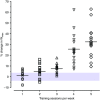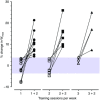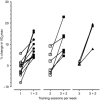Refuting the myth of non-response to exercise training: 'non-responders' do respond to higher dose of training
- PMID: 28133739
- PMCID: PMC5451738
- DOI: 10.1113/JP273480
Refuting the myth of non-response to exercise training: 'non-responders' do respond to higher dose of training
Erratum in
-
Corrigendum.J Physiol. 2018 Apr 1;596(7):1311. doi: 10.1113/JP275942. J Physiol. 2018. PMID: 29603268 Free PMC article. No abstract available.
Abstract
Key points: The prevalence of cardiorespiratory fitness (CRF) non-response gradually declines in healthy individuals exercising 60, 120, 180, 240 or 300 min per week for 6 weeks. Following a successive identical 6-week training period but comprising 120 min of additional exercise per week, CRF non-response is universally abolished. The magnitude of CRF improvement is primarily attributed to changes in haemoglobin mass. The potential for CRF improvement may be present and unveiled with appropriate exercise training stimuli in healthy individuals without exception.
Abstract: One in five adults following physical activity guidelines are reported to not demonstrate any improvement in cardiorespiratory fitness (CRF). Herein, we sought to establish whether CRF non-response to exercise training is dose-dependent, using a between- and within-subject study design. Seventy-eight healthy adults were divided into five groups (1-5) respectively comprising one, two, three, four and five 60 min exercise sessions per week but otherwise following an identical 6-week endurance training (ET) programme. Non-response was defined as any change in CRF, determined by maximal incremental exercise power output (Wmax ), within the typical error of measurement (±3.96%). Participants classified as non-responders after the ET intervention completed a successive 6-week ET period including two additional exercise sessions per week. Maximal oxygen consumption (V̇O2 max ), haematology and muscle biopsies were assessed prior to and after each ET period. After the first ET period, Wmax increased (P < 0.05) in groups 2, 3, 4 and 5, but not 1. In groups 1, 2, 3, 4 and 5, 69%, 40%, 29%, 0% and 0% of individuals, respectively, were non-responders. After the second ET period, non-response was eliminated in all individuals. The change in V̇O2 max with exercise training independently determined Wmax response (partial correlation coefficient, rpartial ≥ 0.74, P < 0.001). In turn, total haemoglobin mass was the strongest independent determinant of V̇O2 max (rpartial = 0.49, P < 0.001). In conclusion, individual CRF non-response to exercise training is abolished by increasing the dose of exercise and primarily a function of haematological adaptations in oxygen-carrying capacity.
Keywords: cardiorespiratory fitness; hemoglobin mass; non-response; trainability.
© 2017 The Authors. The Journal of Physiology © 2017 The Physiological Society.
Figures




Comment in
-
Exercise and trainability: contexts and consequences.J Physiol. 2017 Jun 1;595(11):3239-3240. doi: 10.1113/JP274031. Epub 2017 Feb 17. J Physiol. 2017. PMID: 28185284 Free PMC article. No abstract available.
-
Reply from David Montero and Carsten Lundby.J Physiol. 2018 Aug;596(16):3809. doi: 10.1113/JP276455. J Physiol. 2018. PMID: 30133813 Free PMC article. No abstract available.
-
Exercise dose and individual response of healthy adults: is it time to re-evaluate exercise responsiveness and training recommendations?J Physiol. 2018 Aug;596(16):3807-3808. doi: 10.1113/JP276141. J Physiol. 2018. PMID: 30133814 Free PMC article. No abstract available.
References
-
- American Thoracic Society (2003). ATS/ACCP Statement on cardiopulmonary exercise testing. Am J Respir Crit Care Med 167, 211–277. - PubMed
-
- Bergstrom J (1962). Muscle electrolytes in man. Scand J Clin Lab Invest 14 Suppl 68, 1–110.
-
- Bonne TC, Doucende G, Fluck D, Jacobs RA, Nordsborg NB, Robach P, Walther G & Lundby C (2014). Phlebotomy eliminates the maximal cardiac output response to six weeks of exercise training. Am J Physiol Regul Integr Comp Physiol 306, R752–R760. - PubMed
-
- Bouchard C (2012). Genomic predictors of trainability. Exp Physiol 97, 347–352. - PubMed
Publication types
MeSH terms
Substances
LinkOut - more resources
Full Text Sources
Other Literature Sources
Medical

